
by Mary Caperton Morton Thursday, January 5, 2012
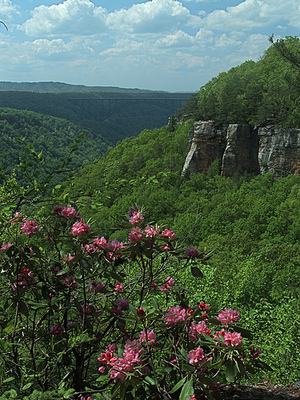
West Virginia's New River Gorge. The New River Gorge Bridge attracts daredevil jumpers who dive off the span with parachutes, splashing down in the river below. Mary Caperton Morton
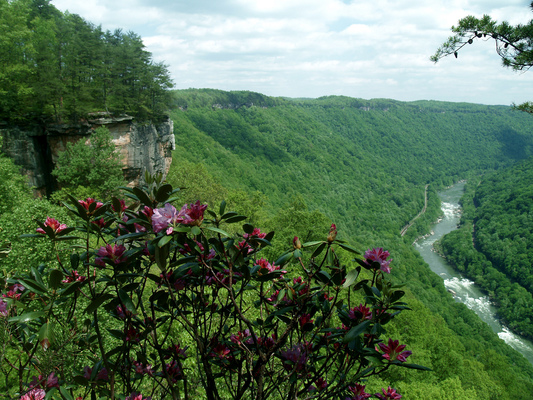
The New River Gorge. The New River is one of the oldest rivers in the world, perhaps second only to the Nile. The two rivers have something else in common - they are two of the only rivers in the world to flow north. Mary Caperton Morton
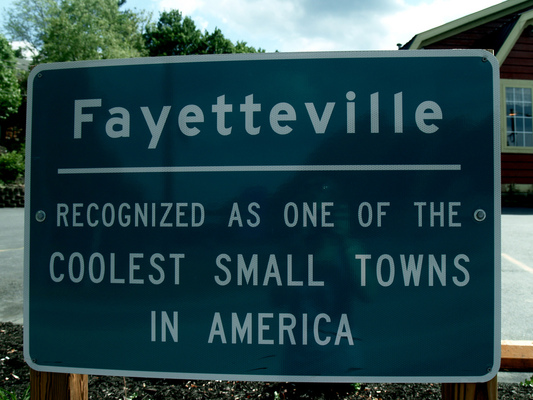
Welcome to Fayetteville. Mary Caperton Morton
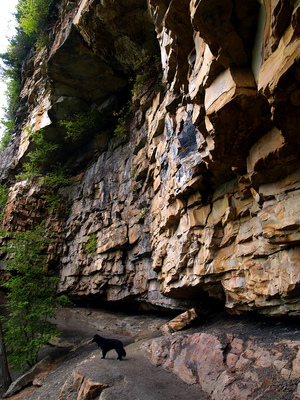
A coal seam in the New River Gorge. Mary Caperton Morton
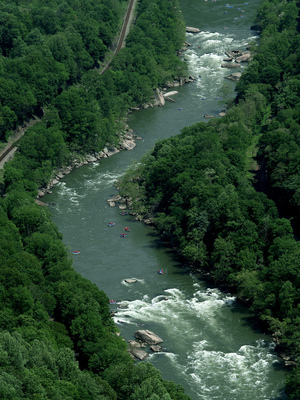
Rafters on the whitewater rapids of the New River. Mary Caperton Morton
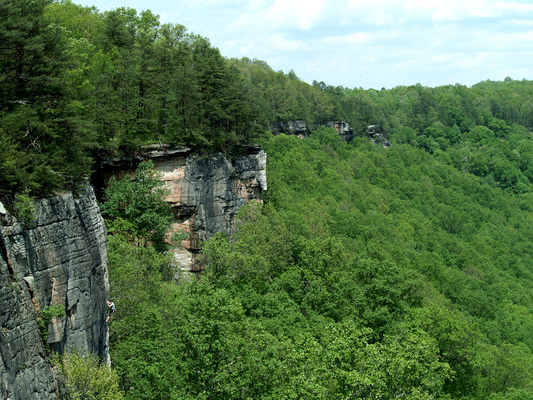
Climbing the New River Gorge Mary Caperton Morton
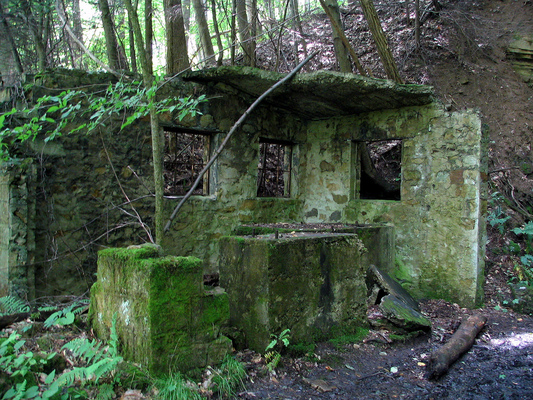
The ruins of Kaymoor, a mining town built in 1899 and once home to 1,500 workers and their families. Mary Caperton Morton
When Budget Traveler magazine named Fayetteville, W.Va., one of the “Coolest Small Towns in the USA”, it credited not just the town’s young atmosphere and unique shops, but also the local geology, which is nothing short of spectacular.
Fayetteville sits on the precipice of the New River Gorge, a 500-meter-deep trench carved by the raging New River through the Appalachian Mountains of southern West Virginia. Not only is Fayetteville cool and its gorge spectacular, but with the East Coast’s best rock climbing and world-class whitewater rafting, the New River Gorge might also be the most thrilling geology field trip on earth.
The New River’s name is misleading, since it is thought to be one of the oldest rivers in the world, perhaps second only to the Nile. The New River began as an ancient river system known as the Teays, which was created 350 million years ago when Europe, Africa and North America collided to form the supercontinent Pangaea. The impact uplifted the Appalachian Mountains to Himalayan heights and the Teays formed to drain the range’s western slopes. From its headwaters in what is now North Carolina, the Teays journeyed north through the Virginias to Ohio, then turned west to drain into a vast inland sea that is now the site of the Mississippi River basin. About 60 million years ago, West Virginia went through another period of gradual uplift. The swift-running Teays River cut into the mountain faster than the rate of uplift, thus maintaining its ancient course and creating the deep gorge seen today.
As it rushes through the gorge, the New River cuts through 350 million years of geologic history, exposing layer upon layer of sandstone, shale and carboniferous coal. Coal, formed from dead plants deposited 200 million years ago, has played a big role in the more recent history of the New River Gorge. Because the river had already done most of the work to expose the coal seams, this area was one of the first places to be mined in West Virginia. The completion of a riverside railroad in 1873 opened the New River Valley to dozens of mining companies and thousands of workers. From 1900 to 1962, miners hacked more than 16 million tons of coal from the walls of the gorge.
During mining’s heyday, more than 60 coal towns were built along the banks of the New. Today, virtually all of them are abandoned. The best known of these ghost towns is Kaymoor, built in 1899 and once home to 1,500 workers and their families. To see the Kaymoor ruins, stop by the Canyon Rim Visitors’ Center off route 19, just south of Fayetteville, to pick up a trail map and then follow the driving directions five kilometers to the Kaymoor trail head. From there it’s a 10 kilometer round trip hike down to the crumbling buildings, dilapidated houses, rusting mining equipment and long-cold coke ovens of Kaymoor.
Coal isn’t the only famous rock in the gorge; its red sandstone cliffs are world-renowned among rock climbers. These sixty-meter high cliffs boast a climbing repertoire unmatched almost anywhere on earth. Thousands of climbing routes snake up the vertical rock faces and on any given day you can see some of the sport’s best rock stars tackling some of the world’s most challenging climbs. The best place to watch for climbers is from Diamond Point along the Endless Wall Trail, which is also possibly the best panoramic view of the gorge and a prime picnic spot. If you want to try climbing yourself and need a guide or are an experienced climber looking for beta (that’s climber-speak for info) head to Water Stone Outdoors on Main Street in Fayetteville, home of New River Mountain Guides and Climbing School.
The New River’s Nuttall Sandstone cliffs are 98 percent quartz, perfect for finger-tip grips, and even better for forming a deep V-shaped gorge: The erosion-resistant rock is what makes the walls of the New River Gorge so steep. The gorge squeezes a lot of water down a narrow chute, making for extreme whitewater rapids that are not for the faint of heart. Much of the course consists of difficult class IV and V rapids, although there are sections and tributaries for rafters of all skill levels. A number of rafting companies based in Fayetteville and nearby Oak Hill offer guided trips down the river. Ace Whitewater, Raft West Virginia and USA Raft are three reputable licensed outfitters. If you do decide to go shooting down the rapids, while you’re paddling like a madman, at least try to steal a glance up at the 500-meter-thick cross-section of geologic history flashing by above you.
Aside from the endless cliffs and rushing whitewater, the New River Gorge boasts another awe-inspiring feature: the New River Gorge Bridge. Travel from one side of the gorge to the other was once a harrowing 45 minute trip on a treacherous one-lane road, but the construction of the bridge in 1977 shortened the driving time to less than a minute. Towering a dizzying 292 meters above the river, the New River Gorge Bridge is the second highest bridge in the U.S. — and with a span of 566 meters, it is also the second longest steel arch span in the world.
With those credentials the bridge attracts another breed of daredevil to Fayetteville: BASE jumpers. The BASE jumpers (an acronym for the four platforms from which they leap: Building, Antennae, Span and Earth) dive off a gangplank erected at the center of the span and deploy their parachutes in time to splash down in the river almost 300 meters below. Every October on “Bridge Day” the bridge is closed to traffic and opened to hundreds of parachutists and thousands of revelers. If you already have 50 jumps under your belt, you can register to leap, otherwise, peruse the 200 booths selling food and arts and crafts, and enjoy the daredevil entertainment and breathtaking fall foliage from the bridge.
For rock lovers, traveling in geology is always interesting, but few destinations offer an extreme adrenaline rush like the New River Gorge. In certifiably “cool” Fayetteville you’ll find delicious food (check out the Cathedral Café and Pies n Pints) and great lodging (the beautiful White Horse B&B, for example) or you can rough it with the rest of the outdoors crowd at the National Park service campground across the road from the Canyon Rim Visitors’ Center. Bridge Day this year is October 18 — make reservations now, because cool little Fayetteville fills up fast!
© 2008-2021. All rights reserved. Any copying, redistribution or retransmission of any of the contents of this service without the expressed written permission of the American Geosciences Institute is expressly prohibited. Click here for all copyright requests.